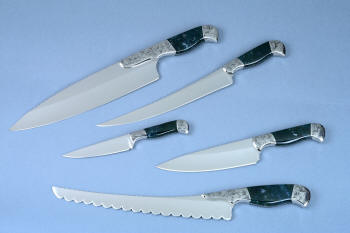Please note: I do not sell woods or wood stock.
I only use woods on my own knife handles.
This page contains:
Questions, answers, pictures, descriptions, and synonyms of domestic and exotic hardwoods used in modern knife handles,
knife stands, cases, and blocks.
It is my goal to make this the best page of exotic woods
used in knife handles on the net. I've worked hard to
illustrate and describe the woods used in custom knife handles,
components, stands cases, scabbards, sheaths, and fittings. Although
I'm better known for my gemstone custom knife handles, I've worked
extensively with woods in this field for over 30 years. I'll
continue to add to this page as I complete new projects and find
pictures of other uses of these fine woods. All of the knives
pictured on this page are my own, all the woods listed I've
personally worked with. The comments are based on my personal
experience with these woods.
Remember, woods vary in appearance and texture even within the
same board, so there is no absolutely uniform dictate on a
particular wood's performance. Being porous, woods can absorb and
release moisture and other agents that they're exposed to which will
change their makeup, appearance, and sometimes size.
I am committed to making completely and clearly the best knives in the world.
--Jay Fisher
More
Page Sections:
-
Answers to the 11 most commonly asked questions about wood used in modern custom knives
- Why wood knife handles?
- What is the difference between hard woods, soft woods, and just plain wood?
- Are there original or unique hardwoods just for knife handles?
- What makes one wood usable on a knife handle, and another not?
- What about Dymondwood®, Pakkawood®, and Staminawood®?
- What about stabilized woods?
- What is the difference between a burl, straight grain, or wavy grain, figure, and texture?
- Aren't the darker woods harder than lighter colored woods?
- Are some woods more expensive than others?
- What about the names of hardwoods?
- What about general descriptions of these hardwoods?
- Notes, disclaimer about web photos and wood appearance
- On to the woods!
-
Woods I have currently available for projects
- Details and pictures on
60 of the most commonly used woods in custom knives
- Over
340 alternate and local names for these woods
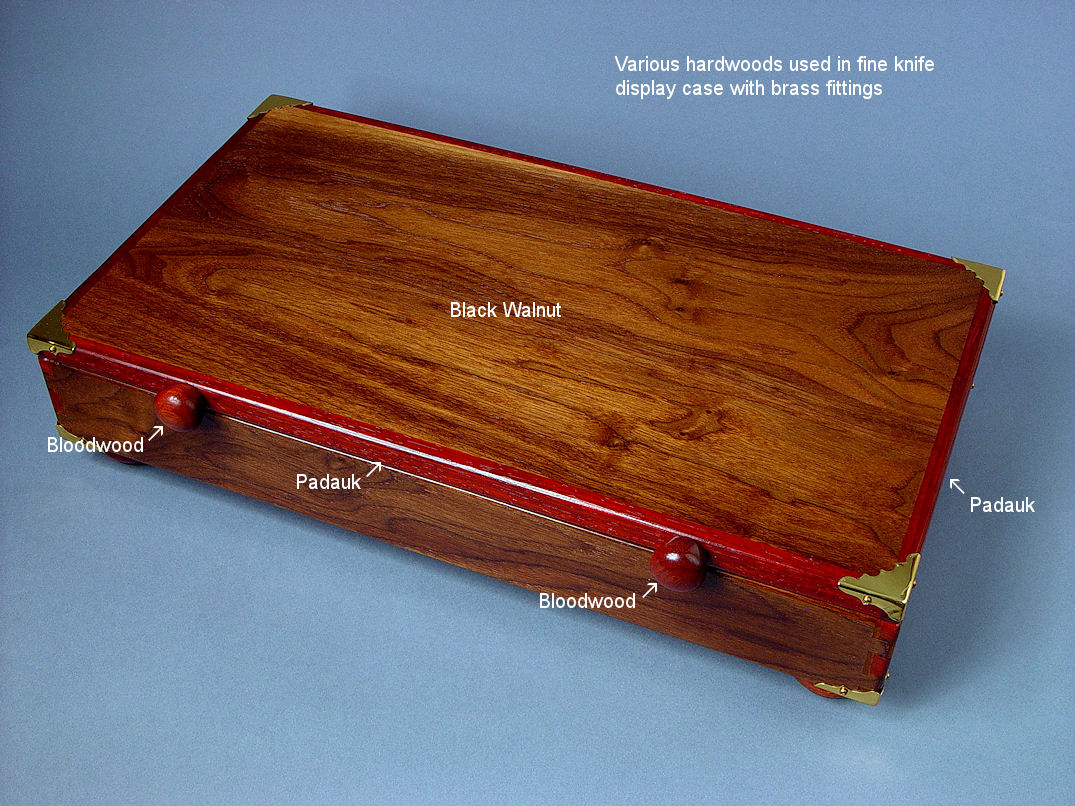 More
More about this "Duhovni Ratnik"
and case
Wooden knife handles have been used ever since the invention of the knife. Woods are organic, warm to the touch,
comfortable to hold, and can be long lasting. Wood handles are used on nearly every kind of fine tool,
instrument, or even vehicles, including a ship's wheel. Hardwoods exhibit a distinctive class of fine taste, and
throughout time, will always be cherished for their value. Hardwoods compliment
metals very well, and are artistically sound, choice exhibits. In knives, they
have been, and will always be a standard.
Back to Topics
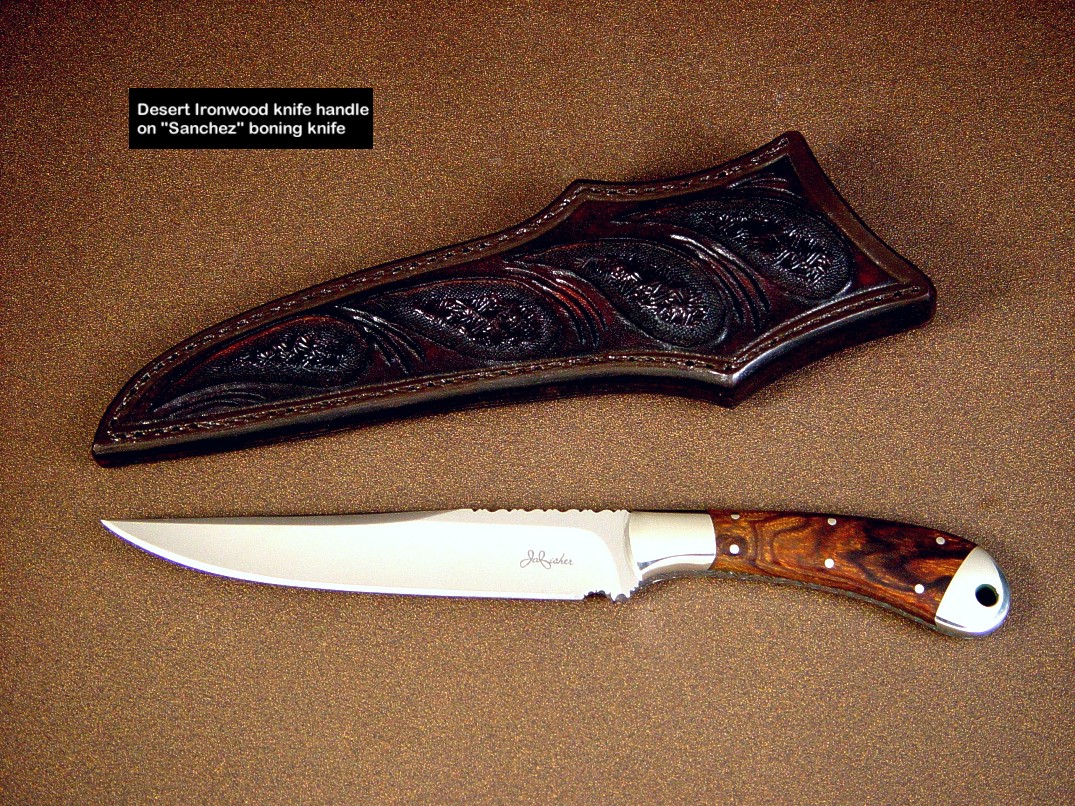 More
More about this "Sanchez"
The word "hardwood" actually refers to trees that are deciduous. Deciduous trees are
actually angiospermous trees: trees that loose their leaves every winter, bear flowers, and have broad leaves.
Softwoods refer to conifers. Coniferous trees have needles or are evergreen, and have cones.
Because most of the deciduous trees have wood that is physically dense and more resistant to penetration,
they were coined "hardwoods." This may not necessarily be the case though, as some conifers
have very hard, tough wood, and some deciduous trees have wood that is fairly soft.
There is also confusion about which part of the tree has the most usable wood, and in knife handles,
it's almost always the heartwood that is used. The heartwood of the tree is the inner core, extending
from the pith to sapwood, where live cells have been converted to gums, resins, minerals, and other substances
resistant to decay. The heartwood is almost always harder and more durable than the sapwood. The sapwood is
the living layers of the tree, is almost always lighter in color and density than the heartwood, and is more
permeable to liquids and susceptible to decay.
Back to Topics
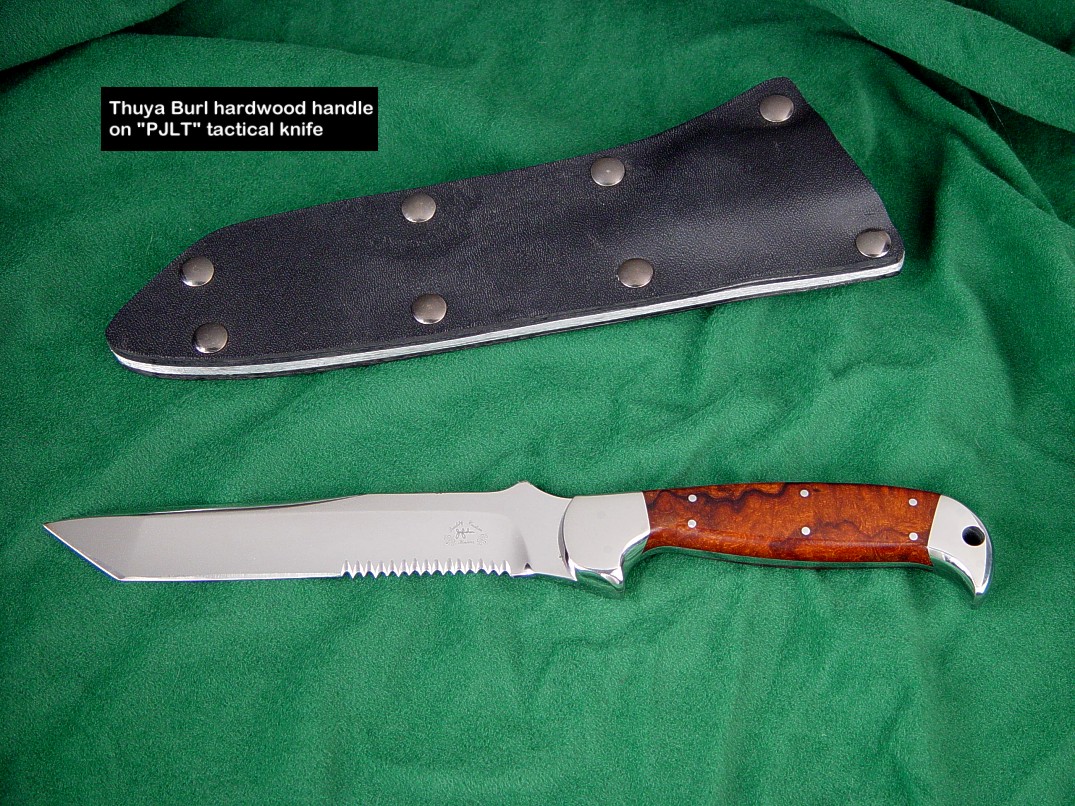 More
More about this PJLT
Looking at the availability of various exotic hardwoods, one would think that only a dozen or so rate
use for a custom knife handle. This is simply not true as there are hundreds of applicable woods,
and many of these woods exist in a group that has hundreds of species. For example, in the family
of ebony (Ebenaceae), there are about three hundred species of shrubs and trees distributed throughout the
temperate and mild regions of the world.
Though it may be said that each piece of wood is unique, many are so uniform that
distinctive differences cannot
be claimed. In example, one piece of ebony looks pretty much like another, uniform and black. But most woods
exhibit some figure, color variation, or pattern that makes them attractive.
In other species, every piece of wood is different, and slabs cut from
the same block look like distinctly different woods.
Back to Topics
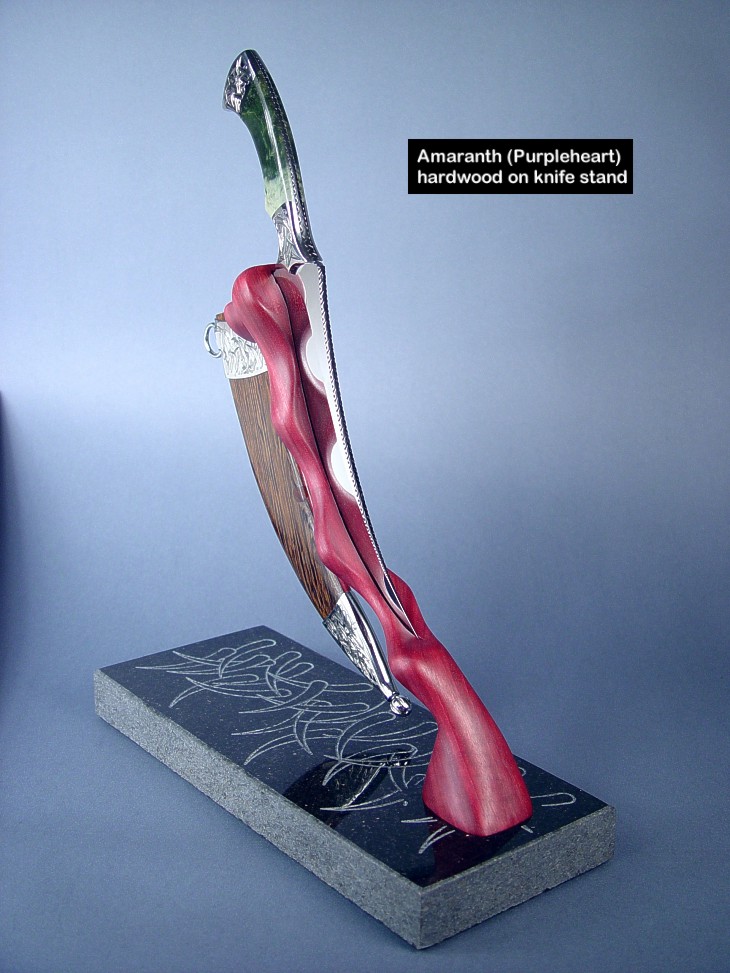 More
More about this Desert Wind
Woods used for handles (any kind of handle) must be fairly hard to be long lasting.
They must be durable, able to hold fine curves and thin sections like the high points of finger grooves,
flutes, and bolster dovetails without breaking, chipping or splintering. They must be smooth
to the hand, polish well, and fairly close-grained so debris, staining, and
contamination is kept at a minimum. They must be attractive. Another point
not often considered is their tendency to expand an contract with moisture and
temperature changes. All organic materials change to some extent. Good
knifemakers strive to use stable woods and minimize movement that can loosen the
wood handle from the metal knife tang. Makers also judiciously apply
pins, screws, and attachment hardware to secure the wood to the knife
tang, and should also bed the wood with modern adhesives and compounds
to secure and seal the critical wood-to-steel junction.
Back to Topics
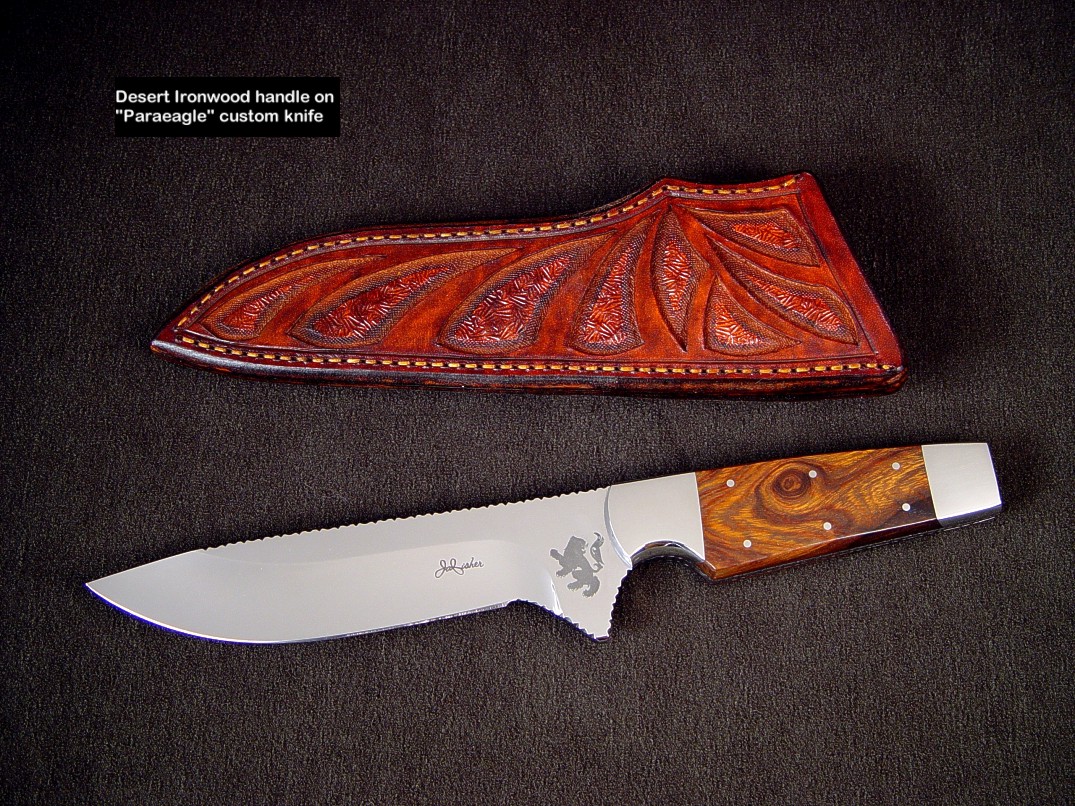 More
More about this Paraeagle
These are actually plywood products, usually constructed from birch.
Dyes are vacuum-impregnated into the wood, then the wood is pressure impregnated
with polymer or phenolic resin at very high pressures, then highly
compressed into plywood blocks. With the high compression rates and
solid massing of the material, this creates a very dense, tough, and
solid wood product, that is pretty much waterproof when wet. Though
I don't use these often (some of the colors are quite garish), some
clients request them and I'm happy to accommodate them. These
stabilized laminates are very durable, polish brightly, and are long
lived. Read more details about these manmade wood products and see a color chart and comparison on
my
"Manmade Knife Handle Materials" page at this bookmark.
Back to Topics
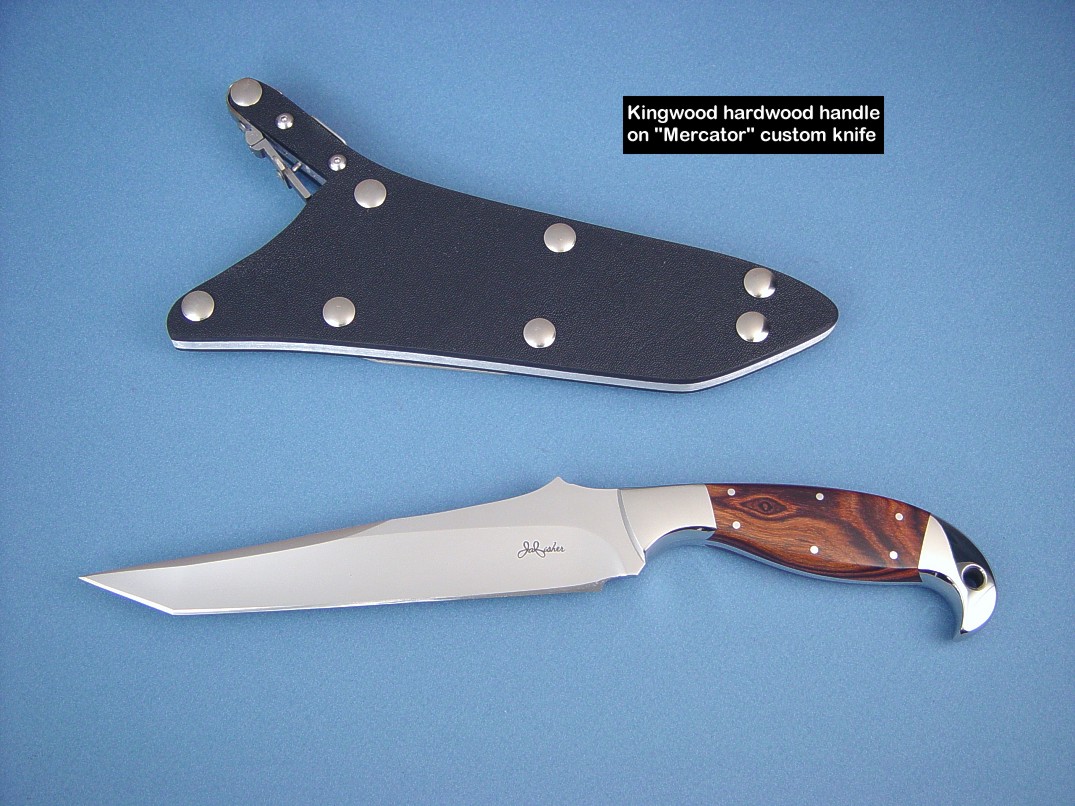 More
More about this Mercator
Woods that are stabilized are woods that are usually too weak, too porous, or too plain to be used without treatment.
Like the laminates described above, dyes are sometimes impregnated into the wood, then
the wood is pressure-impregnated with polymer or phenolic resin at
very high pressures. With the high rates of pressure, this creates a
very dense, tough, and solid wood product, that is pretty much
waterproof. I use stabilized hardwoods like Box Elder Burl,
Buckeye Burl, Redwood Burl, Maple Burl and a host of others.
The process creates a very durable plasticized wood, unique in color that
polishes brightly, and is extremely durable and long lasting. For woods that are not
naturally self-sealing, oily, or resinous, this is the
only way to get woods that are waterproof for kitchen use and marine environments.
Here are some examples on this page of stabilized woods with
photographs of finished handles:
Back to Topics
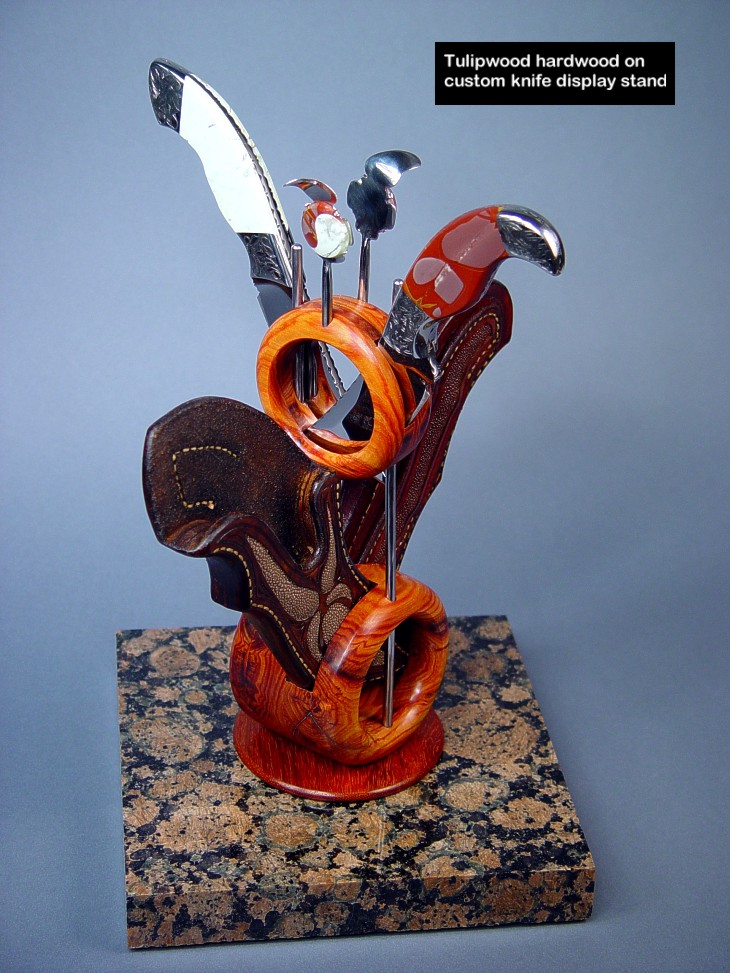 More
More about this Izanami, Izanagi stand
There are many terms used to describe woods.
In the individual wood type descriptions below, you'll find
descriptions of hardness, durability, and appearance. Though all of
these terms may not be used in my work (I seldom taste the hardwoods,
unless I'm really hungry), these are the accepted and general
descriptive features that identify specific woods in most scientific and
detailed texts.
- Grain: the direction and orientation of wood cells, particularly the fibrous elements. There are six general
types of grain:
- Straight grain
- Irregular grain
- Diagonal grain
- Spiral grain
- Interlocked grain
- Wavy grain
- Figure: The natural design or pattern seen on the surface of the wood and may include:
- Growth rings
- Vascular rays
- Knots, burls, buttresses, crotches, swells
- Variations in color
- Blisters, quilting, ribbon, stripes, wavy, fiddleback
- Texture: the size and variation of size of the wood cells; the "feel" of the wood surface
- Coarse: wide vessels, broad rays
- Fine: narrow vessels, thin rays
- Even: woods that show little or no contrast between seasonal growth
- Color
- Odor and Taste
- Luster: the ability of the wood to reflect light
All of these features and distinctive attributes determine the value, longevity, and
durability of woods used on knife handles.
Back to Topics
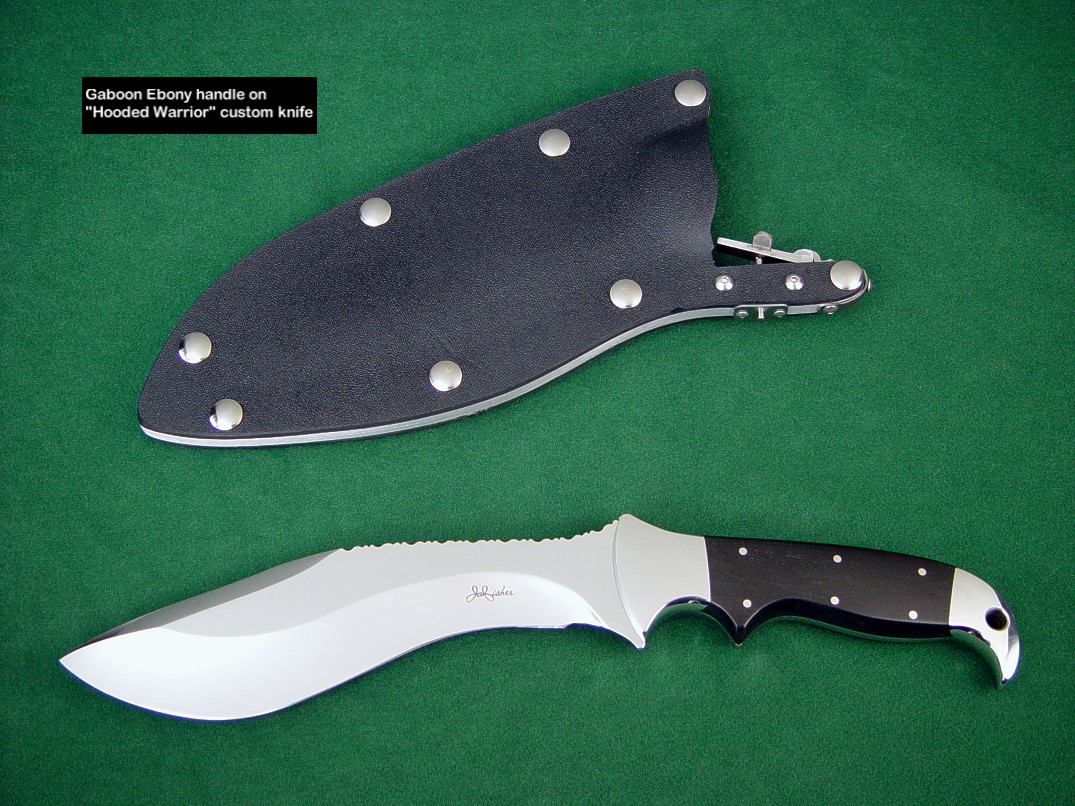 More
More about this Hooded Warrior
Not every light colored wood is as soft as pine.
Not every dark wood is as hard as ebony.
It is a common misconception that darker woods are harder and thus, more
desirable than lighter colored
woods. It reminds me of the 1970s when every den had to have dark or walnut colored paneled walls, furniture,
and accessories. This may be the very reason that these dens were later called man-caves, because they were
almost always dark. Guys would stain pine to a walnut color to darken it, and make it seem more valuable, as
the most valued North American hardwood is American Black Walnut. But I'm sure the practice goes back much
further, as even in historic pieces, they were ebonized to make the wood seem richer and more valuable.
There is often a persistent belief that the darker woods are harder, and more durable as well as more
masculine and bold in visual punch. This is wrong; there are many very hard, tough, and durable woods that
are light in color and well-outlast darker woods like walnut. Woods like Olive, Bois d' Arc, Peach, Pear,
Apple, Pecan, Hickory, and Ash are all very hard, dense, and durable woods, and every one of those will
outlast Walnut. Even Red and White Oak are harder and more durable than European, American, or Tropical Walnuts.
Simply put, darker does not mean harder or more valuable.
Back to Topics
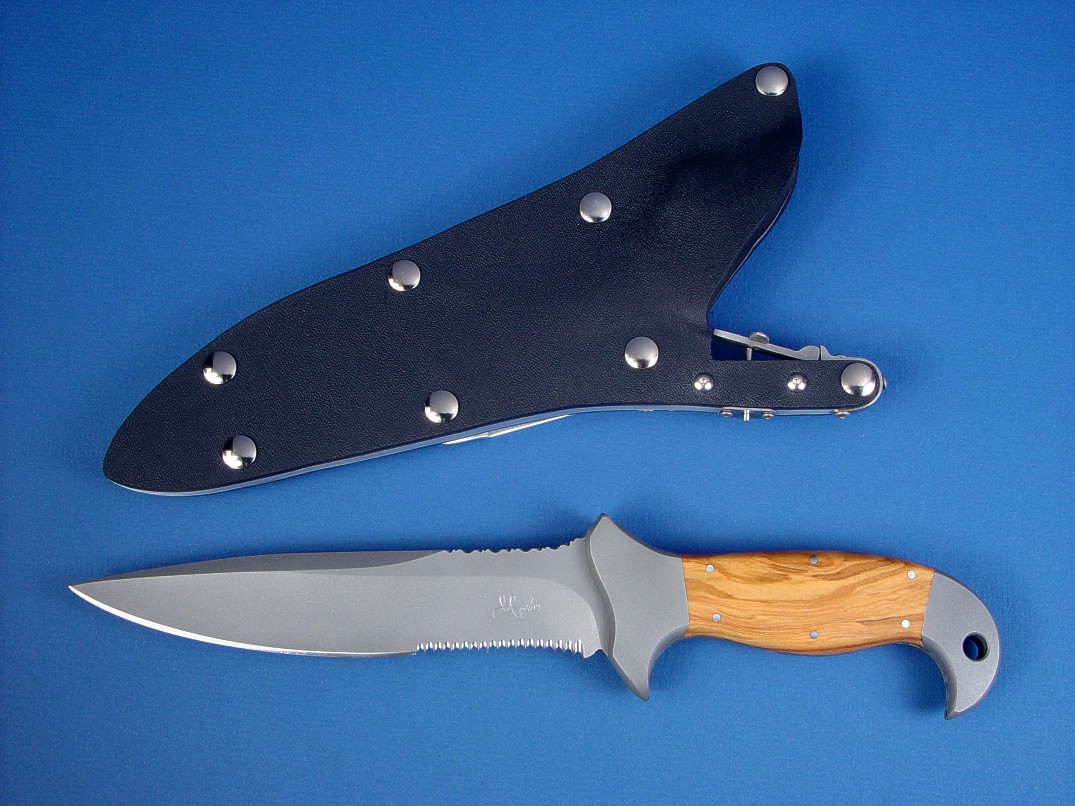 More
More about this Macha Navigator
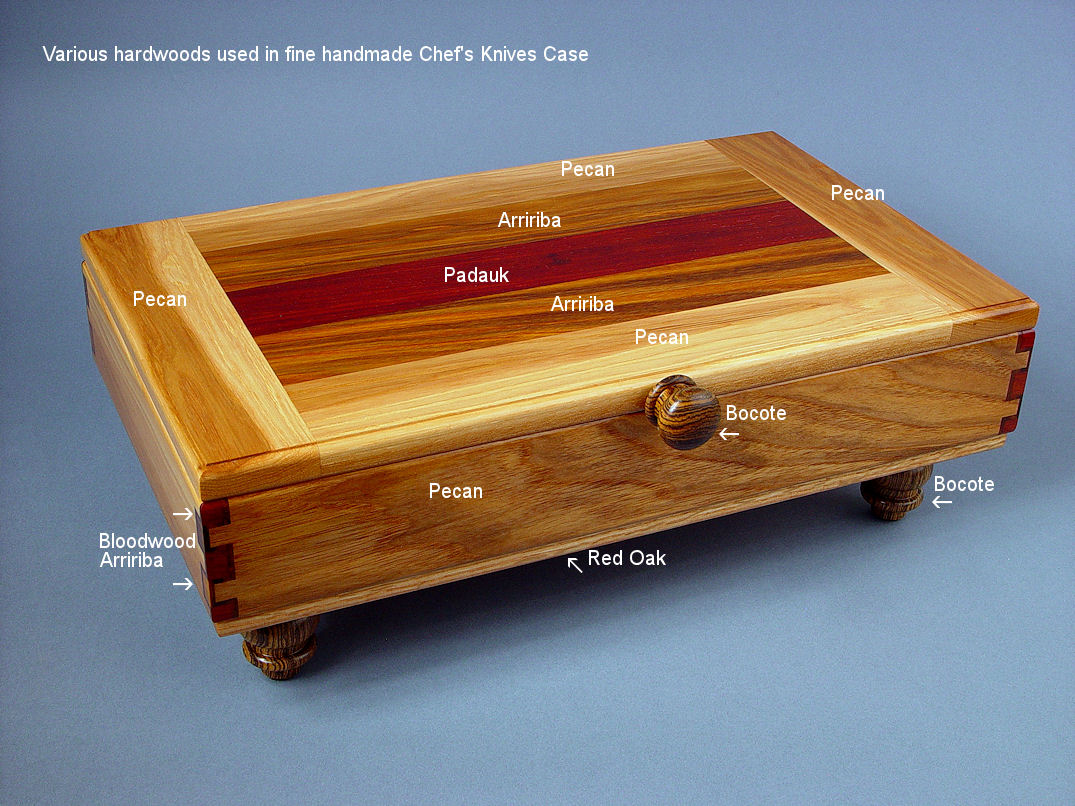 More
More about this Chef's Knives
Set and case
You bet they are. Woods like snakewood and
pink ivory come at a high price. Sometimes, certain
cuts of woods (like Desert ironwood and burls) that show plenty
of figure and interest cost up to ten times per handle for the knifemaker, a
cost that increases the value of the knife, and the final cost of the knife to
the client. There is also a lot of misinformation on the internet and in
reference books about woods, their availability and their value (a good example
is the listing about Desert Ironwood below).
Environmentalists will decry all cutting and
usage of wood, yet most woods are completely renewable, and many sources of
"rare and exotic" woods we use come from wood farms and plantations. It is in
their best interest to hype woods as extremely rare and irreplaceable, as this
will drive the price up, giving suppliers more profit. Could it be worthwhile
for lumber interests to allow some environmentalists claims to go unchallenged
while the price of wood increases because of "rarity" or "limited supply?"
There is also a difference in use and volume.
The smaller a piece of wood is cut, the higher the price per pound. For example,
go to a hardware store and look at a piece of
all-thread rod. A one foot bar will cost three to five times as much per foot as
a six foot bar. Why? Is the cut more expensive? Is the little piece more
valuable per inch than the larger one? No, the store knows that if you don't
need a six foot piece, then you're willing to pay more per foot for a smaller
piece just to get the job done. Knife handle scales are that way. You can go to
Mexico and pay $30 US for fifteen pounds of ironwood, enough material to make 30
or more handles, or you can buy a pair of scales from a knife making supply
company for $30 each. Sure, you sometimes get to pick and choose the particular
cut, and they do tend to weed out the unusable scrap. But sixty times the
price? Makers and knife clients will pay that though, if they think they're
getting something original. Yet there are thousands and thousands of knives out
there with similar handles.
There are more expensive woods, and there are
less expensive woods. Many cost more than the steel in the blade. The cost is
not usually dependent on durability, hardness, or longevity of the wood handle material,
it is almost always the appearance, and nearly all of them are beautiful in
their own way. Of course, I have to consider my costs, working costs and
expendables, and rarity in the final evaluation of the price of the knife, case,
stand, or artwork, so that too, figures into the pricing.
Back to Topics
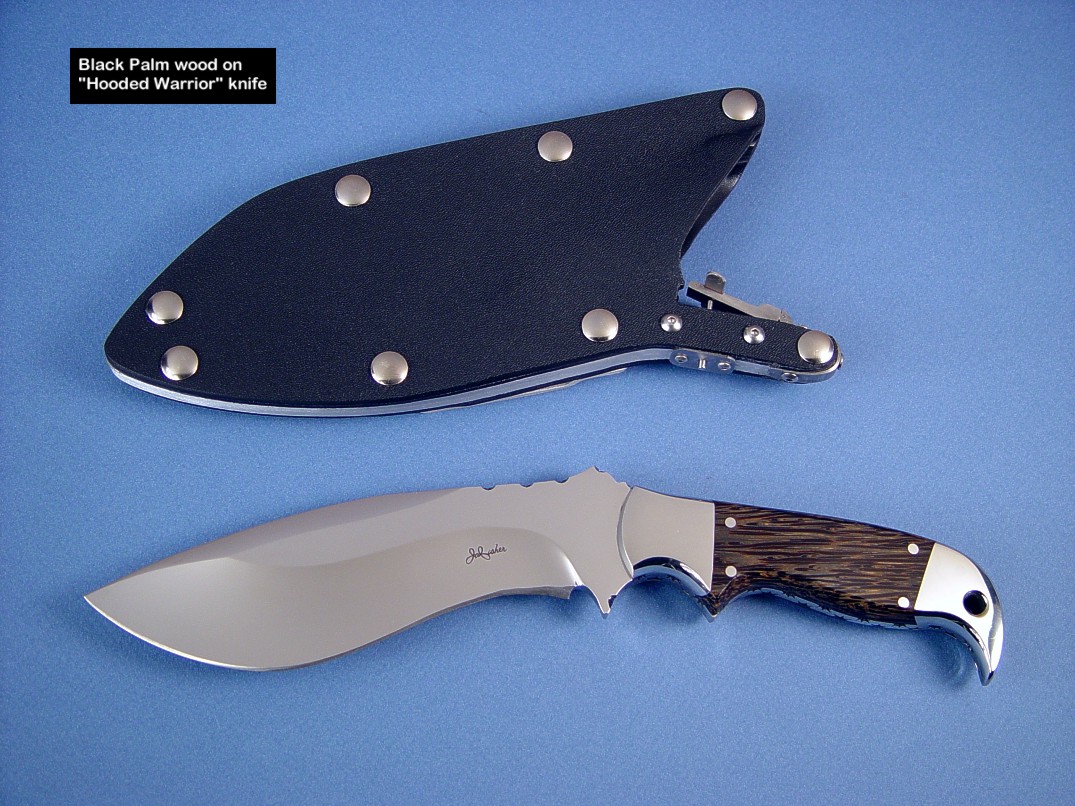 More
More about this Hooded Warrior
Hardwood names can be bewildering. Every
country has a host of names all for the same wood, other countries name the same
wood in their host of names, then dealers and suppliers add their own
name to the wood, and before you know it the wood has twenty different names.
Take Ironwood, for instance. There is a lot of confusion as the term
"Ironwood" refers to many trees in many nations. The Latin term iron wood
is Pau Ferro, another host of descriptive wood types bear that name. It
seems that every country has some hard wood or tough tree that deserves the name
Ironwood, and there are over 80 distinct species from all over the world
that are commonly named Ironwood. Common trees that bear the Ironwood
name are: American hornbeam, Black Ironwood, Desert
Ironwood, Olive trees, Hop Hornbeam, Persian Ironwood, Ipe, Ekki, Rose Chestnut,
Ceylon Ironwood, Australian Ironwood, and even Lignum Vitae, the densest wood
known. Then there is Pau Ferro, Pao Ferro, Pao Fierro: from two different
continents, all different trees. Some of the woods referred to have several
species (and some have hundreds of species!), so the traits I've experienced and
noted may not apply to all the woods of the same name. At the
synonym list at
the bottom of this page, I've tried to nail down the types of each, including
cross referencing the common and trade names of the woods. This page consists of
a lot of research, and I learned a lot compiling it.
Back to Topics
 More
More about this Desert Wind
I've compiled quite a bit of information on
this page, and in doing so, found a lot of errors in the texts of reference
manuals on woods and on the internet. Some woods are listed in the books as
"non-durable," and in my experience, they are extremely hard, durable, and long
lasting. Many woods are listed as rare or nearly impossible to get, but look on
the internet and there are literally hundreds of sources to acquire them.
The information and descriptions below are derived from nearly 40
years of my experience using the woods for knife handles, cases, stands,
and in other cabinet, furniture, and turning projects. So, while many
dealers and suppliers of exotic and domestic hardwoods make claims about
their usefulness and applications, I've actually used them: sawn, cut,
drilled, carved, sanded, and polished them, and my clients have used
them in the field, in their collections, and even in active military
combat. I've applied that real world experience with valid information
to nail down a specific description of the wood.
Back to Topics
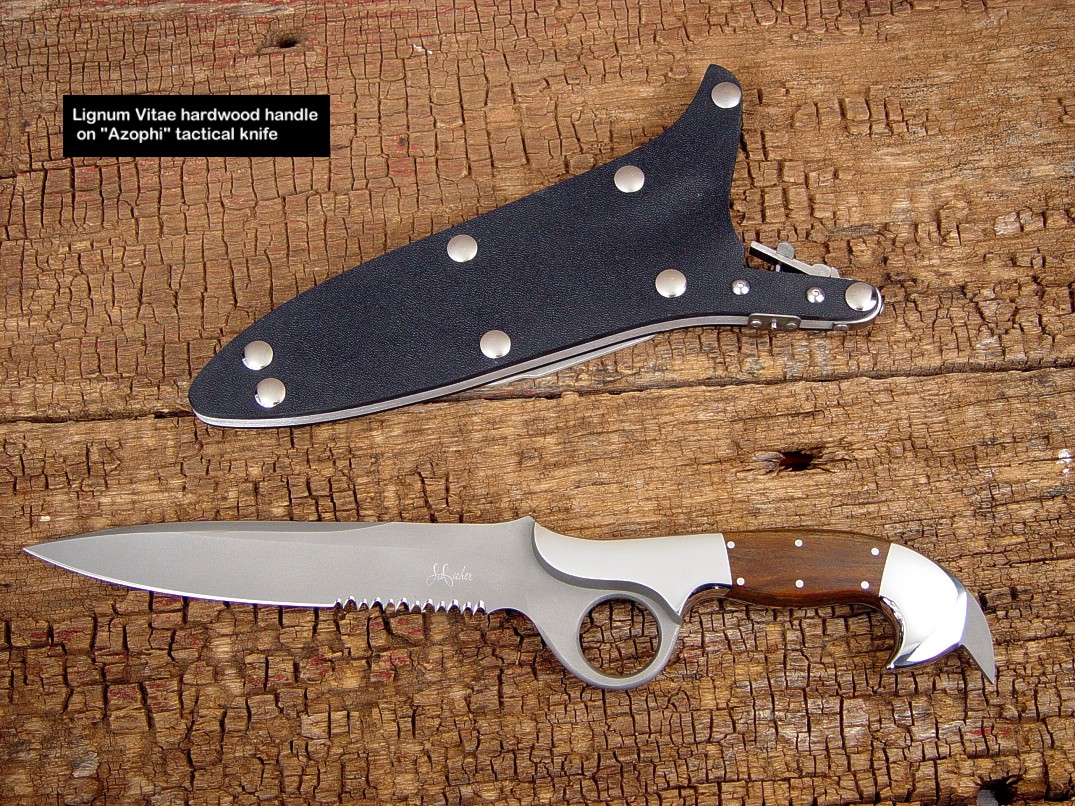 More
More about this Azophi
I've tried my best to give an
accurate color and figure rendering of these exotic and domestic
woods and handle materials. Some things to consider are:
- some woods change color over time (mostly due to regular oxidation processes)
- some woods change appearance when exposed to fluids or contaminates (some even change with
normal oils from human hands)
- the wood selected for handle material may vary in grain, grade, and color (I can't regulate
the exact appearance, even in the same board stock).
- there may be additional considerations that apply to your choice in a knife handle
material (like thin sectional support, impact resistance, and texture)
- no two pieces of wood are alike, even when book-matched.
- There are some considerations
also for photographic rendering of these knife handle materials:
- The color may vary depending
on original photography, scanning methods, color rendition of
editing programs, and the color setup of your monitor
- The color of your actual handle may vary depending on the above factors and what light
and intensity you view it in (the color of light depends on the
source; florescent lighting, incandescent lighting, and daylight
all vary greatly in color)
- The grain and figure may be more or less pronounced
than the actual material. This is also due to
limitations and setup in the computer viewing
components, like the photo editing program, your monitor
and settings, and the horribly weak limitation of the
internet overall, which limits color, contrast, and
definition.
- Some pictures have been borrowed from suppliers and sources, and I can't absolutely
guarantee their accuracy (but they're very close!)
Back to Topics
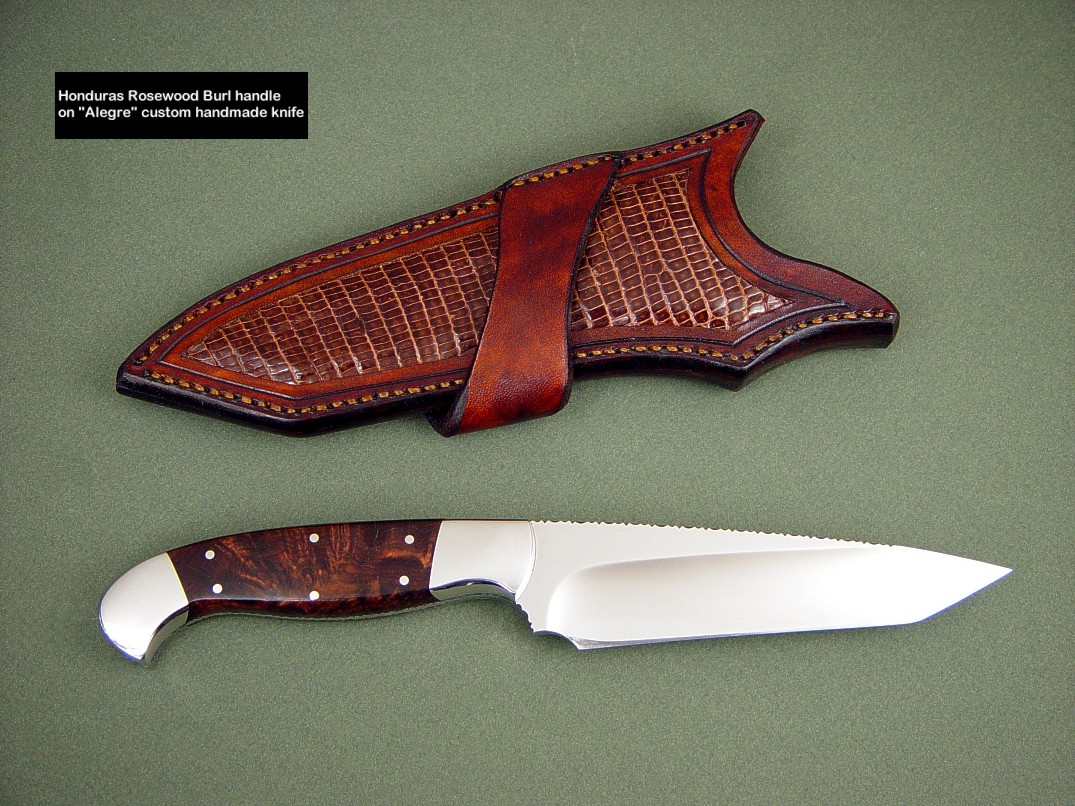 More
More about this Alegre
Here is a list of hardwood materials I've used in custom knife handles.
Many of these I have in stock, and most are available if I don't stock them.
Please remember that
I don't sell wood stock, only use woods on my own knife handles!
Back to Topics
Here are the woods I currently have available for projects. I may have small amounts (enough for one or two knives) or I may have large planks
and many board feet. Over the decades, one amasses many types and amounts of woods, and they come from all over the world.
The amounts and species vary, and I'll try to keep the list up to date.
Please note that I don't sell woods!
This first list details woods available for handles.
See below for woods available for sculptural stands, cases, displays, blocks and larger items.
- Amboyna Burl
- Apple
- Apricot
- Arririba (Canarywood)
- Birch: Stabilized, Dyed, Pakkawood, Dymondwood
- Blackwood, African
- Bloodwood
- Bocote (Cordia)
- Bog Oak (Ukraine)
- Bois d'arc - Osage Orange
- Bubinga
- Cacique
- Cocobolo
- Courbaril
- Desert Ironwood
- Ebony, Gaboon, Royal Striped
- Eucalyptus: Curly, Quilted
- Eucalyptus, Gum, Red Burl
- Goncalo Alves
- Guayabillo
- Honduras Rosewood Burl
- Honduras Rosewood
- Imbuyia
- Jobillo
- Kingwood
- Lacewood
- Lignum Vitae
- Madagascar Rosewood
- Madrone Burl
- Mahogany, Quilted
- Maple: Fiddleback, Bird’s Eye, Burl, Hard, Rock, Straight
- Maple: Big Leaf Burl
- Maple: Spalted
- Mesquite: natural, stabilized
- Mora (Guatemala)
- Olive
- Padauk
- Palm, Black
- Pao Ferro
- Peach
- Persimmon
- Pink Ivory
- Purpleheart (Amaranth)
- Quebracho (Argentina)
- Red Coolibah Burl
- Redheart
- River Gum Burl
- Rosewood, East Indian
- Snakewood
- Tamboti - African Sandalwood
- Thuya Burl
- Tulipwood
- Wenge
- Zapote
- Zebrawood
- Ziricote
This second list details woods available for sculptural stands, cases,
displays, blocks and larger items.
See above for woods available for
handles.
The amount, volume, and character of these woods varies, so not all
are available for all projects.
Back to Topics
Wood Handle Material Descriptions with Thumbnail Photos
- African Blackwood
Dalbergia melanoxylon:
- Origin: Mozambique, East Africa. Exceptionally hard
and dense species, black, but not as solid black grain as ebony. Straight
grained. It is actually a rosewood, not an ebony. It makes a great knife
handle, and is strong, long lasting, a bit aromatic and holds details and
pins well. It is actually more stable than ebony. Used in musical wind
instruments (like clarinets, oboes and bassoons), bearings, pulley blocks,
carvings. Polishes smoothly, holds well, oily and resinous.
- Amaranth (Purpleheart)
Peltogyne spp. F. Leguminosae:
- Origin: Tropical America from Mexico to Brazil.
Moderately hard an medium dense hardwood, initially brown when cut, but
turns dark purple when oxidized or heated. Although a bit open grained for
knife handles, it offers interesting color patterns with torch work.
Straight grained. Polishes easily, slightly porous. Occasional streaks of
grain with white lines. Used also on cabinets, heavy outdoor construction,
gymnasium apparatus, diving boards, skis, chemical vats.
- Amboyna Burl
Pterocarpus indicus:
- This wood is widely touted as the world's most expensive burl,
but I'm not sure if that's true, since it's readily available in
literally hundreds of online web sites, wood distributors, and
sources. It is a strikingly beautiful wood, and a great variety of
appearance can be directed by arranging the cuts of the wood to show
different figure. It's a wood that originally came from the island
of Amboyna (thus the name) but is well known by many different names
today, and mostly originates in Borneo and grows throughout the East
Indies and the Phillipines. The wood is fairly hard, dense, and solid, and works well
with few cracks or checks. It does not easily oxidize or change, so
is very stable. It's very difficult to tell Amboyna from Thuya burl.
The wood was widely used in furniture built in the Empire period
(1804-1814) and was scarce during the last century, but now is much
more common. It looks great on a knife handle, but its main usage
historically was in veneers. The wood is also used commonly in
non-burl form, simply known as amboyna. Look to
the list below to see the many other names for this wood.
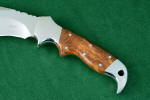
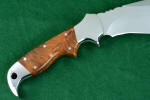
- Arririba (Canarywood)
Centrolobium spp.:
- Origin: Brazil. From a small tree, color yellow to
tan with red and black streaks. Used also in naval architecture, cabinet
veneers. Polishes well, is very stable, holds its color which is bright and
interesting. Tight grained, stunning in knife handles, knife hard sheaths
and scabbards, and stands. Straight grained, some wavy grain.
- Australian Blackwood
Acacia melanoxylon:
- Origin: Hundreds of species of the Acacia genus:
South America, South Africa, India, Australia, Tasmania. Despite the name,
the heartwood is reddish brown, bands of dark brown with a reddish tint.
Some oxidizes deep red over time. Makes a dense, tight, solid and long
lasting knife handle. It's very hard, moderately dense, straight grained,
polishes very brightly, with a fine finish, and is stable. Used in high
quality furniture, billiard tables, gun stocks, ornamental turnery and
musical instruments.
- Birch Laminates (Stabilized)
usually Betula papyrifera:
- Origin: Factory modified and created from birch.
These laminates are sold by the name Dymondwood®, Pakkawood®, Staminawood®,
and others are vacuum dye impregnated and then pressure treated compressed
laminate plywood products. Most of the wood used is birch, and these composites
were made currently by Rutland Plywood Company, before a fire
destroyed their plant. Now other companies are making this type of
laminate. These are tough,
durable, long lasting and waterproof wood products, and sometimes have bold
colors, stripes, and figure. They are a popular wood product for knife
handles, so yes, I use them too, occasionally. The shocking patterns can
look a bit ridiculous, so I try to stay away from the types that look like a
carnival clown. But, since I do custom orders, and clients get what they
want, some opt for these products because of durability as well as color,
and they are quite durable on the knife handle. Important: see also
my page
on man made handle materials which has extensive information on these wood
products at this bookmark.


- Bloodwood (Satine)
Brosimum paraense:
- Origin: South America. This is a fairly common
hardwood, bright blood red. Moderately hard, takes a good polish, very
durable and long lasting. Straight grained, heavy. I've used this in custom
knife handles for decades, and in stands, hard sheaths, and fittings, it lasts
very well with moderate sealing with wax or cyanoacrylate. Used in turnery,
fine cabinets, ornamental woodwork. There are several species of this group,
and some distinguish between Satine, Bloodwood, and Cacique. The only
differences I've seen is that Caciqe occasionally has small white deposits
in some of the grain (silicates).
- Bocote (Bucote)
Cordia alliodora:
- Origin: Mexico, Central and South America. A very
dramatic figured wood, with light tan background and sometimes wild dark
brown stripes in both straight grain and knots, occasional burls, and waves.
Medium density, very porous, takes sealers well, somewhat permeable. In
knife handles, great care must be used in finishing, as the grain picks up
polish and metal swarf, but once finished, is a bold and long lasting
handle. Used in fine cabinetry, furnishings. Mildly fragrant. Porosity can
be a problem when finishing, as it takes polish and debris unless carefully sealed.
- Bog Oak Quercus Species:
- Origin: Ancient wood, some in Europe, Ukraine, Croatia, Western Europe.
Also called Morta, Bog-wood, This is a very special wood, long
prized for its rarity, darkness, and stability. Some ancient bog oaks were
even said to possess magical powers. This is not plain contemporary
oak (below). Modern use of the term Bog Oak
may refer to many species of mineralized and buried woods, but this is not correct. True bog oak is of the oak (quercus)
species. It is wood that has fallen in a peat bog, into anaerobic
wet bog, and therefore does not decay, but is preserved for hundreds
to thousands of years. As it sits in the bog, water carries minerals
into the cellular structure of the wood, darkening and hardening it.
The longer the oak has been in the bog, the darker it becomes. This
makes a very stable and strong wood, highly resistant to decay, in
actuality, mineralized oak. A very prized and expensive wood, used
to make primarily knife handles and even sculpture and jewelry.
Important to this wood is a dating method or record of provenance;
without it, it could be just darkened oak. Many sources of bog oak
in western Europe have played out an its extraction and sale is
tightly regulated, though I've had a writer inform me that in
Western Ireland, great amounts are being "cleared out of the way
to make room for trees for telegraph (electricity) poles." If
this is true, this could be a great supply of a material that is
expensive and hard to acquire. It's also sad that this very special
material is ignored and left to rot. Once it's gone, there will be
no more...
- Bois d'arc (Osage Orange)
Maclura pomifera:
- Origin: Southwestern United States. The name "arc of
the bow" is from the wood's use as bows for Native American tribes. This
smallish tree was encouraged in Oklahoma and Texas as hedgerow, and produces
some of the hardest, toughest wood in the Americas. It's been planted more
than any other tree in America. The wood is bright, clear, straight grained
lemon yellow in color. It is hard, dense, heavy, and takes a bright glossy
polish on knife handles or other implements or tools. Care must be taken not
to overheat when working with the wood, as it darkens and burns easily.
Little change occurs on the knife handle during aging. When applied to a
knife handle, it stands alone in color and clarity; I know of no other wood
that can be confused with Osage orange. The tree bears inedible "oranges"
and the wood has an almost citrus scent when working. It's also been used
for veneers, wheels, archery bows, accents in inlay and marquetry, and for
dyes.
- Box Elder Burl
Acer negundo, F.Aceraceae:
- Origin: Northeastern United States. Box elder is a
member of the Maple family. It is a medium sized tree, and is planted often
for shade, the form of the tree has multiple branches and therefore whorls
and crotches in the wood. The wood of interest in this tree is the burl
wood, hard, twisted, knotted, with beautiful figure, whorls, and curves. It
is a favorite of mine in knife handles, original, wild, and highly figured.
The burl is often pressure treated and impregnated with dyes and either
polymer or phenolic resin (see
stabilized woods on this page) for a gorgeous and striking knife handle material. As
with all stabilized woods, it is mostly waterproof, long lasting, takes a
fine polish and finish, and is very stable.
- Buckeye Burl
Aesculus glabra or Aesculus flava:
- Origin: Central United States from Alabama to
Pennsylvania, originally imported from Germany. Most people know this tree
associated with the name "Buckeye" and Ohio, it is the state tree and the
name of college teams. Many people have seen the buckeyes, the seeds of the
tree, they are hard, dark brown, round about an inch in diameter, and
glossy. The are supposed to resemble the eye of a buck deer, hence the name.
The seeds are poisonous. The tree isn't much to look at, small to medium
sized, resembling a horse chestnut, with smelly twigs and flowers, and for
the most part the wood is soft. But the wood has rippled, wavy figures, and
the burl is magnificent when stabilized. I've used stabilized buckeye burl
for years and it makes a beautiful, serviceable knife handle. I've even got
a buckeye burl table in my home, and it has fascinating figure. The wood is
also used for paper, splints, wooden limbs, and veneers. It's even
used for coffins!

- Bubinga
Didelotia africana or Guibourtia Demeusei:
- Origin: Gabon, Camerouns. Reddish brown fairly hard
and dense exotic wood with interesting broad bands of figure, sometimes
wavy, takes a very nice polish and finishes well. Durable, resistant to
stains and doesn't darken with age. Varnishes or oils well. Makes a great
knife handle, sheath, knife case, or stand component. Used in veneers, fine
cabinetry, building small boxes.
- Cherry (Black Cherry) Prunus serotina
- Origin: Eastern North America. This is not your domestic cherry tree, nor is it the decorative cherry that is imported
from Japan and is the focus of cherry blossom festivals. This is
American Black Cherry, a staple in building fine cabinets, furniture, turnings, carvings, and musical instruments, so it's not
surprising that it's important in knife making, too. In the
domestic wood trade, it's simply called cherry. While I don't use it for handles (there are more striking woods), I do use it
in the studio in both my sole authorship and collaborative works for cases, stands, and chef's knives blocks. It's stable, predictable, and
takes a very nice finish. It's got a very fine grain, with small, tight pores, and not much figure, but this does not stop it from being one
of the most valued and dominant premier domestic hardwoods.
- Cocobolo
Dalbergia retusa:
- Origin: Pacific seaboard of Central America from
Mexico to Panama, Costa Rica, Nicaragua. This is probably the most popular
wood for fine knife handles and gun grips. It is a very dense, very oily,
very resinous hardwood. When first cut, it exhibits striking patterns of
color, rich reddish browns, tans, oranges, yellows, dark reds, and dark
browns and can be straight grained of highly figured. After a year or two in
service, it darkens considerably, sometimes to near black, but keeps some
visual interest. It's very stable. The wood gives off a rich, attractive
odor when worked, but has none when finished. This wood has a long
reputation for dependability. It's used for turnery, handles, bowling balls,
sculpture, carving, scientific instruments, boat wheels, forks and spoons,
limited veneers, and wooden jewelry. Working it is tricky, as the dust can
induce a reaction similar to poison ivy. I know of one knifemaker who can
never be exposed to the dust again, because of a severe reaction. I've used
it for years, but take full safety precautions. This has nothing to do with
the final use, though, as once it's finished, it's completely stable and
non-reactive. Probably the most popular material for handmade custom knife
handles.
- Courbaril (Jatoba)
Hymenaea courbaril:
- Origin: Southern Mexico through Central America and
the West Indies, Brazil, Bolivia, and Peru. This is a heavy, dense hardwood,
with reddish brown and darker brown stripes. Takes a very good polish, is
lustrous, rich, and seems to glow from within. Takes a very long time to
dry, I had a piece that took over five years to season before it quit
moving! It's difficult to work, but worth it. It makes a bright, glassy
polished finish on a knife handle. High shock resistance leads to its use in
handles, looms, wooden gear cogs, high class furniture flooring and stair
treads because of its great resistance to wear. It is interesting to note
that the tree is the source of copal, the gummy, resinous substance used to
seal boats, and in glues and adhesives. Ancient copal became fossilized,
creating the gemstone amber.
- East Indian Rosewood
Dalbergia latifolia:
- Origin: India, Southern Asia, Pakistan, Sri Lanka,
Java. A medium density wood, naturally oily and resinous, but with large
open pores that must be sealed with a sealant, or debris will accumulate,
and polishing will dig out or undercut the sanded finish. Because of this
porosity, it's more suitable to knife cases, stands, and holders than
handles, in my opinion. It's dark purple with black streaks, occasionally
light to dark brown, reasonably attractive, and fairly inexpensive. Cracks
along the grain easily. Used in guitar fingerboards sides and backs, pool
cues, fine furniture, doors, veneers, shuttles, turnery, pens, furniture.
- Ebony
Diospyros spp:
- Origin: Africa: Nigeria, Ghana, Cameroons, Zaire, Gaboon,
also Ceylon, India. A very popular exotic wood, in demand since ancient
Egyptian times. The heartwood is black, the sapwood is called "white ebony."
Straight grained, some curliness, fine, even texture, smooth, lustrous
finish. It's very stable, high in strength, and can be brightly polished.
It's been used in handmade knife handles for centuries, with dependable,
uniform results and longevity. Used in sculpture, carving, inlays, door
knobs, billiard cues, piano and organ keys, stringed instrument finger
boards, guitar backs, castanets, and for fine veneers.
- Fruitwoods:
- Origin: Domestic. Fruitwoods used in custom knife
handles can be very stable, beautiful, and long lasting. Pear wood is rosy
pink, cream background, and fine and close grained, and finishes and
polishes well. It's used on instrument quality rulers and drafting
instruments and marquetry. Pecan, which is a species
of hickory, produces fine, even grained reddish wood with brown stripes.
Some prime pieces make great knife handles, cases, and stand components.
It's used in veneers and furniture. Apple, once cured, makes very fine knife
handles, with close grain, with a reddish brown color, and is used in golf
club heads. Peach is a very hard, tight-grained hardwood that is very limited in
supply, but makes a great hardwood knife handle. There are other fruitwoods and nut woods that are suitable for
fine custom knife handles.
- Goncalo Alves
Astronium fraxinifolium:
- Origin: Brazil, Paraguay, Uruguay. This is a very nice
hardwood, with striking patterns in medium golden reddish brown to dark
brown streaks and waves. It finishes well, is very hard and heavy, and looks
great on a knife handle, taking a glassy finish. Because of the wild
figuring, it's been used for picture inlays and is also used for dampers of
grand pianos, boatbuilding, fine furniture. It has a reputation for being
one of the most beautiful exotic hardwoods.
- Guayabillo (Verdolago)
Terminalia oblonga or Terminalia Amazonica:
- Origin: Tropical forests of Central and South
America. This is a smooth, even grained and textured wood, of fairly hard
and dense. The color is red-brown, with straight figure and darker brown
growth lines. It has high impact strength, polishes well, and is very
durable. I haven't used it much for custom knife handles, but like what I
have and will continue to use it in future projects. It's also used
extensively for flooring, decks, utility poles, tool handles, furniture,
turnery, structural timber, and veneers.
- Honduran Rosewood
Dalbergia stevensonii:
- Origin: British Honduras, Brazil, Belize. This
hardwood has a long history of usage and export, it's pinkish brown with
some purple and darker and lighter bands. It's hard, heavy, oily and
resinous, and makes a superb knife handle. The color doesn't change (like
cocobolo), and it takes a very keen polish and stays that way. It makes a
great knife handle, and keeps it's pattern and figure even through rough and
long term handling. It's used for the manufacture of xylophones and
marimbas, furniture, cabinets, bank fittings, paneling, carving, sculpture,
bowls. This is a very highly prized exotic wood rumored to be diminishing in
supply, but I see plenty of it on the market all the time. Makes me wonder
if this is a ploy to keep the prices high.
- Honduran Rosewood Burl
Dalbergia stevensonii:
- Origin: Same as Honduran Rosewood above. Unlike the
listing above, this wood IS very rare; I was lucky enough to come across a
burl of Honduran Rosewood years ago, and have some of it left. I've never
seen any more of it it my whole career of knife making. The burl is filled
with knots, wild circular forms and waves, there is not one straight line on
it. Most of the ringed patterns are smaller than a dime, and it's hard to
get pieces uniform enough for a knife handle, but when I can, it's worth
it. Very beautiful stuff.
- Imbuyia or Imbuya
Phoebe porosa:
- Origin: Southern Brazil. Chocolate brown to
olive-yellow, and may be variegated, fine textured, mostly straight grained,
but sometimes wavy. It takes a medium high polish. This is a medium weight,
medium hardness wood, and is decorative. I've had good luck with it in knife
handles, when well sealed, and it makes a beautiful case or knife stand. It
looks somewhat like walnut, but with more figure, and is used for cabinets,
furniture, joinery, sculpture, turning, rifle butts and gun stocks. Some
veneers are made from it.
- Ipe
Tabebuia avellanedae:
- Origin: Tropical America. Olive-brown colored
heartwood, with yellow lapachol powder in the grain, so there are tiny
yellow lines in the finished wood. It's similar to teak in appearance.
Satiny finish. It's very dense, moderately hard, and very long wearing. The
grain is straight. It's not a common knife handle material because it's a
bit boring, with pretty much olive straight lines and bits of yellow. Good
for cases, stands and other decorative knife components. It's used for
decks, docks, fine veneer, railway ties, and work requiring high wear
resistance and resistance to decay. A very tough wood
- Ironwood (Desert)
Olneya tesota:
- Origin: Sonoran Desert, Americas. Ironwood deserves
special attention. There is a lot of confusion as the term "Ironwood" refers
to many trees in many nations. It seems that every country has some hard
wood or tough tree that deserves the name Ironwood, and there are over 80
distinct species from all over the world that are commonly named "Ironwood."
Common trees that bear the Ironwood name are: American hornbeam,
Black Ironwood, Desert Ironwood, Olive trees, Hop Hornbeam, Persian
Ironwood, Ipe, Rose Chestnut, Ceylon Ironwood, Australian Ironwood, and even
Lignum Vitae, the densest wood known. The Ironwood that knifemakers mostly
use is Desert Ironwood, that comes from the Sonoran desert in Arizona and
Mexico. It is very hard and dense, naturally oily and resinous, and takes a
very bright glassy polish. It's impervious to just about any thing, and long
wearing. The colors and patterns of Desert Ironwood can be wild and
beautiful, straight grained, or demure. Some of it has an almost chatoyant
(cat's eye) effect in the figure. In custom knives, it's probably the second
most common handle material, next to Cocobolo. Outstanding pieces with high
figure are very prized in the custom knife field. It's also used in
carvings, sculpture, and small boxes, as well as inlay, accents, and even
jewelry. There is a lot of misinformation around about how rare
it's becoming and how hard it is to find, but it's commonly for sale
everywhere, and often marked up outrageously. One only needs to go to any market in
Mexico, and you'll find hundreds of badly done carvings out of really nice
Ironwood at a very reasonable price (they slab out nicely). It's
probably enough to know that much of it is used to make charcoal,
which speaks to the volume of trees and ironwood out there.
- Kingwood
Dalbergia cearensis:
- Origin: Brazil. This fine wood is a member of the
rosewood family. It has a rich violet-purple striping to black, with cream
undertones. It has a fine texture, is uniform and mostly straight grained,
somewhat waxy, and finishes and polishes brightly. It's a very heavy, dense
wood, and moderately hard. The name is derived from its preference by French
royalty and the Georgian period of English furniture, and was the preferred
wood for thrones and royalty. I've used it extensively in fine knife
handles, and it's a great, long lasting, hard, dense glassy handle,
wonderful to touch. It's use is mostly decorative, though, because the tree
is rather small. Used in turnery, sculpture, veneers, marquetry, and to
restore that old French and English furniture. Another wood claimed to be
scarce, yet there are many sources of it.
- Lacewood Cardwellia
sublimis:
- Origin: Australia and Europe. Often called Silky-oak,
but is not an oak at all, and there seems to be confusion
between Northern Silky Oak and Southern Silky Oak; we'll deal with
the Northern Silky Oak. This is a striking wood, with a "basket weave" or
"fish scale" rayed appearance of the figure, from 1/4" down to 1/16"
lacelike patterns, though it's mostly straight grained. It is only of medium
density and light hardness. It's tan to shell pink and light brown, very
open grained, so sealing is necessary, but it makes a fine knife handle.
Long term, the grain raises somewhat, and that helps to increase the tactile
feel and grip on a knife handle. Also used in decorative boxes, marquetry,
ornamental cabinetwork, and veneers. In Australia, where it is common, it's
used as a shade tree, and the lumber for building and shuttering, wood
floors, plywood, and paneling.
- Lauan (Philippine Mahogany) Shorea negrosensis
or Shorea contorta
- Origin: The Philippine Islands. Lauan (White Lauan, Red Lauan) has been called Philippine Mahogany for decades but it is not a
mahogany at all, though the name persists. This wood is light weight but fairly strong, and open-pored so does
not make a good knife handle. I've used it before in knife stands, cases, and scabbards, because it is tough,
durable and predictable. It has a very nice color when oiled and waxed, and is dimensionally stable. It's used
also in furniture and sliced for veneers.
- Lignum Vitae
Guaiacum officinale:
- Origin: All of the central Americas, from southern
Florida to Venezuela. The name sometimes refers to three species of trees,
all called Lignum Vitae (The wood of life), whose resin was believed to cure
illnesses. The wood is greenish black, mostly straight grained, and
incredibly dense, heavy, hard, and tough. It's known as the hardest,
heaviest wood in the world. It's three times as hard as oak. Its density is
almost equal to iron, an it withstands a working pressure of 2000 psi! A
full one third of its weight is comprised of gum, so it's used in mechanical
devices such as bearings, and is resistant to most chemicals and decay. As
you can probably guess, it will outlast all other woods in knife handles,
and many manmade materials. Bearings have been made of Lignum Vitae and used
in clocks, fans, air conditioners, underwater marine equipment, and
hydroelectric plants. It's been used as thrust blocks, cable guides, wheels,
and thrust blocks for propeller shafts for ocean liners. The ornamental uses are as sculpture
and turnings. As you can imagine, it makes an almost indestructible knife
handle.
- Maccassar (Macassar) Ebony
Diospyros spp.:
- Origin: East Indies, Sri Lanka, and Ceylon. This is a colorful
ebony, sometimes streaked with yellow or yellow-brown to golden lines. Like
other ebonies, it's hard, resinous, self-sealing and waxy with a fine grain.
It makes a stunning, rich knife handle. It takes a very bright polish, and
is very durable and long lasting. Also used in musical instruments for its
good tonal properties, and carvings, sculpture, furniture, inlays, and pool
cues.
- Madagascar Rosewood
Dalbergia greveana:
- Origin: Madagascar, other islands. This is a very
dark, reddish, burgundy rosewood, which is dense and polishes well. It
maintains color well, is slightly open pored, but makes a fine knife handle.
Also used on musical instruments, furniture, and turnings.
- Maple, Rock
Acer saccharum:
- Origin: United States, northeastern. This is a very
well established hardwood, also called "Sugar Maple." There are two types of
maple, only the hard maple is used in knife handles. It is a moderately
heavy and hard wood, dense and tough, creamy white with a bit of pink, and
can be curly or wavy figured (fiddleback) or with bird's eye. The texture is
fine, even and lustrous, and it takes a high polish. Usually it is stained
chemically in the finishing process to bring out the chatoyant effect in the
wood before it is sealed. It makes a permanent, hard, tough knife handle.
It's been used extensively for skating rink and gymnasium floors, bowling
alleys, butcher blocks, musical instruments, piano actions, sporting goods,
furniture, pool balls, veneers, and the tree is the source of maple syrup.
-
Maple (Fiddleback, Curly, Bird's Eye, Wavy, Tigertail, Tiger)
Acer saccharum:
- Origin: United States, northeastern. Same in every way
to Rock (hard) Maple, but with wavy, curly, or bird's eye figure. Sometimes, specialized
treatments (usually acid washes containing iron) are used to bring out the figure. When properly
applied, these chemical agents actually react with the wood, bringing out
iridescence and deep luminosity.
What most people call
"stains" today are simply pigmented stains and dyes, and are not
the true stains of old. These types of maple make great knife handles.
see Rock Maple above.
- Mesquite (Honey Mesquite)
Prosopis glandulosa:
- Origin: Southwestern United States, Texas, New
Mexico, Arizona, Oklahoma. Also known as (go figure) Ironwood. This
is a medium density wood, takes a decent polish, but must be well sealed on
a knife handle, due to open pores. It is light reddish to pinkish brown,
sometimes with darker lines, and wavy to curly figure, and is sometimes
chatoyant when well polished, sealed and finished. Great in stands, cases,
knife sheaths, and knife components
- Mora
Morus tinctoria:
- This hardwood typically comes from Guatemala, but is native from
Mexico to Bolivia. It has a heavy figure with large stripes of dark reddish brown
contrasting with brighter stripes of golden brown. It is extremely hard and moderately heavy, taking a high,
lustrous polish. Another Mora, often confused, is Fustic, a yellow
dye-yielding tree that is actually Chlorophora tinctoria, a
different species. There is also Morus nigra (black mulberry) and
Morus lactea, from different continents, and are different trees.
Technically, the word morus is latin for mulberry, and all of these
are in the mulberry family. It's used in turnery, pool queues, and fine bowls.
Photos coming soon!
- Oak (American Red Oak)
Quercus rubra:
- Origin: Though there are over 60 species of oak that
grow just in the United States, probably the most common oak used is red
oak. I've even got a tree of this in my yard, and it's beautiful in the
fall, with the leaves turning dark red. The wood of red oak is almost common
in the U.S., but as a general building timber it is expensive. I don't use
it in knife handles, it's too large grained and porus and needs a lot of
sealing, but I use it extensively in stands, boxes, cases and components,
mostly as base and foundation parts. It takes staining well, carves fairly
good, and is a moderately strong, dense wood. It's also used in furniture,
flooring, and joinery.
- Olive
Olea europea or Olea hochstetteri:
- Origin: The Mediterranean, Kenya, Tanzania, Uganda.
Also called Olivewood, the small, twisted olive tree produces some fine
curly figured hardwood for knife handles. it is pale brown with attractive
figure in darker streaks, the texture fine and even. It's very hard and
dense and takes a fine polish, and is very resistant to abrasion. Its figure
makes it very attractive for fine knife handles. It's also been used for
furniture, cabinets, bowls, sculpture, carving, and veneers. If
properly finished, it is smooth and silky to the hand.
- Padauk
Pterocarpus dalbergioides:
- Origin: Central and West Africa. The finest type
(Andaman) from the Bay of Bengal is harvested by convict labor. This is a
commonly used exotic wood of medium hardness and density, it's only
drawbacks being the large open pores that require filling or sealing, or
they will hold debris on a knife handle. It's a wood that when first cut is
bright orange-red, then darkens some with aging and oxidation, sometimes to
dark purple. Its grain is very straight and it wears well. I rarely use it
on knife handles, because of the sealing required, but it works well as an
accent material and on stands and boxes. It does darken with oxidation,
handling, and time. It's also used on cabinets, fine furniture, fancy
turnery, in wooden levels, sculpture, and boat building. Its abrasive
resistance make it usable for flooring.
- Palm, Black
Borassus flabellifer
- Origin: Myanmar, India, and
southeast Asia. This wood is interesting because of its striking
pattern. One of over 1200 palm species, this is the one wood that is
of interest in general carpentry and fine ornament. It is of medium
hardness, and takes a bright, glossy, hard finish. In the sunlight,
the dark streaks glisten with orange translucency. Tight grained and
stable, this is a beautiful wood. Good for small projects, like
pens, bowls, jewelry, and knife handles
- Pau Ferro (Tropical South America)
Machaerium Scleroxylon:
- Origin: Guyana, Brazil, Tropical South America. Not
to be confused with Palo Fierro which is the desert Ironwood listed above.
This is a hard, dense wood with a orange-brown striping, medium density and
hardness, and takes a fine finish and polish. Often substituted for
Brazilian Rosewood. Makes a very nice knife handle. It's also used in
making musical instruments, carving, sculpture. A similar hardwood, not as
dense and with different appearance is below.
- Pau Ferro (African)
Swartizia Madagascariensis:
- Origin: Africa: Cameroon, Nigeria, Zaire, Ivory
Coast, Congo. Not to be confused with Palo Fierro which is the desert
Ironwood listed above. This is a dense, dark brown striped wood with some
reddish-brown highlights and some lighter areas. Its grain is coarser and
more wavy than South American Pau Ferro, and polishes well. Also a fine
knife handle material. Also used in turnings, carvings, sculpture, veneers,
furniture, and musical instruments.
- Peach
Prunus persica:
- Origin: Domestic United States, but native to China and is actually a member of the rose family.
What I'm describing is not the tropical wood called "Peachwood" which is a tropical tree in the
Caesalpinia family; what I'm describing is the wood of the small peach tree, found
domestically in
our United States. Known more for the
fruit, the peach is a tree that has some very fine wood if you can harvest enough of it for a project
or knife handle. The wood is extremely limited because the
tree is small, it frequently has trunk and bark splitting due to its cold sensitivity, and can be
susceptible to borers, leaving holes in the wood. If you can harvest it carefully though, the
wood is definitely worth the trouble. Peach tree wood is very hard and dense, and extremely durable.
It cuts, turns, and takes a polish well, has a very attractive figure and is tight-grained. Because of
limited sizes, peach wood is only available for small projects and use
of this wood is actually rare.
- Pecan
Carya illinoensis:
- Origin: Domestic United States. Great history, has
been a true American tree valued for its nuts at least 8000 years. One
source says the word "Pecan" was derived from the great Algonquin Indian
"Peccan," and another source says the word is derived from "pecane" an
Algonquin word meaning "nut so hard it takes a stone to crack" This is a
good example of the confusing amount and accuracy of information circulating
about woods. Pecan is the third most valuable hardwood in America, behind
Black Walnut and Black Cherry. Pecan is a member of the hickory family, and
as such is a very hard, dense, close grained wood. The color is tan with
reddish brown and darker brown streaks, and can be highly figured, because
straight lengths of grain are not common, due to branching in the wood. I've
used it for knife boxes, knife stands and components, and handles. It's used
for furniture, for fine flooring, veneers, carvings, turnings, and paneling,
and even used in the smoking of meats.
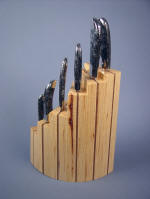

- Persimmon
Diospyros virginiana:
- A small amount of this wood was given to me by a
former knifemaker. He called it Chinese Beeswing Rosewood. It certainly has
a nice, small wavy design in the grain. Makes a great knife handle, with a
noticeable, bold figure and lines. After research I found that Persimmon
wood panels were used in early Chinese, Korean, and Japanese reproduction
furniture, so that is probably why he called it Chinese Beeswing Rosewood.
In sizeable amounts, the wood is rare and valuable, since the heartwood core
of the tree is very small. It's medium brown, moderately dense, and has a
unique wavy figure in the grain. It has a sharp, peppery smell when cut. It
polishes moderately well. It's been widely used for golf club woods, tough
textile shuttles, turnery, and striking tool handles. It' is highly
resistant to impact.
- Pink Ivory
Rhamnaceae:
- Origin: Mozambique, Zimbabwe, Rhodesia, Transvaal,
Natal. A "buckthorn," this wood is supposed to be the rarest wood there is.
It is certainly priced so. It is the royal wood of the Zulus, and only the
chief of the tribe and his sons can cut it. Well, those boys must be pretty
busy, because you can find the wood all over the internet. In the 1980s, it
was pretty pricey, but now, it's almost reasonable. Not a striking wood,
you're paying for the legend here more than anything. In fine custom knives,
makers tout the rarity, not the color or figure. Hard, close grained,
moderately dense, but with very little figure and a light pink in color. It
takes an excellent polish, and has been used for turnings, carvings, pens,
jewelry, pool ques, and musical instruments.
- Redheart (Campeche) (Chakte Kok)
Sickingia salvadorensis (also Sikingia tinctoria)(also Erythroxylum spp) :
- Origin: East coast of Mexico, Central America,
tropical America from southern Mexico to southern Paraguay and Brazil.
The name redheart refers to several different species
of wood, and currently, there is no absolute clear distinction
between them available in the research. They are so close, for our
knifemaking purposes, they are the same. The name Campeche was used
in older sources, probably for the state in Mexico on the Yucatan
peninsula where this wood is found. It's important to note that the
place names of woods are almost useless; there is another wood named
Campeche (Haematoxylum campechianum) that is used to produce a blue dye!
This wood is red, red, red. Sometimes has lighter shades, almost golden,
and often dark, even violet stripes. It has so much red that it is used
to produce red dye. The finish darkens on application of oils or waxes,
so don't expect the initial red color of the new knife handle to stay
bright. Strong exposure to UV light will cause flattening and
fading of the intense red, so it's best not to store it (or any
other knife!) in direct sunlight or intense lighting. It has fairly straight tight grain, finishes well and is of
medium to high hardness. Very stable, similar to teak. Takes a medium
luster, but the somewhat open grain can pick up polishing compounds and
darken unless sealed. Used also in turnery, inlay, boxes, trim, and
carvings. Finding matching colors is somewhat difficult, so it's not
used much in veneers.


- Redwood Burl
Sequoia sempervirens:
- Origin: Western United States, California. Redwood is
a fairly soft wood, so its use on knife handles is only possible when the
wood is pressure stabilized, that is injected with thousands of pounds per
square inch of polymer resin. The burl of the redwood is especially
attractive with reddish brown swirls, curls and knots, and makes a very fine
knife handle (when stabilized). Also used in turnery, bowls, carvings,
fittings, and fine furniture.
- Snakewood
Piratinera guianensis:
- Origin: South America, British Guiana, Brazil,
Venezuela, Colombia, Panama, West Indies. One of the finest woods available,
and highly prized in all its uses. All sources claim that it is highly rare
and scarce, and it's very expensive, but there are hundreds of sources. It's
extremely hard, dense, tight grained, with a spotted figure that is
distinctive and unique. Colors range from reddish brown background to dark
brown spots. It takes an extremely high glassy polish, and is naturally oily
and resinous. It makes a fantastic knife handle, very stable and long
lasting, with a unique appearance that cannot be imitated. Also used in
violin bows, fine umbrella handles, fishing poles, fine canes, veneers,
inlays, and fine furniture.
- Tamboti (African Sandalwood) Spirostachys africana
- Origin: Eastern Africa and Mozambique. This is not the traditional Australian or Indian sandalwood, which
are different species, but the rich, spicy and long-lasting aroma of this wood makes it clear why it's often called
African Sandalwood. The smell is sweeter than that of sandalwood,
and freshly cut, can scent for a long time. This is an oily, hard, colorful and dense wood, used for walking sticks, turnery,
necklaces, and furniture
and has high longevity, durability and stable appearance. It takes a rich,
lustrous shine. Though I've seen it claimed to be rare, this wood is
very available at numerous sources. On the knife handles, a
brisk rubbing brings out a hint of the rich aroma.
- Thuya Burl
Tetraclinis articualta:
- Origin: Along the Mediterranean in northern Africa, Malta, Cyprus.
Thuya burl has a long history, being mentioned in the bible and having been
used during the time of the Roman Empire.
Thuya is almost always used in burl form, which means digging out the root
ball of the tree, which is an expensive way to harvest wood indeed! Thuya
burl is worth it though, yielding dense, solid, and compact burls of wavy figured
hardwood that is strangely uniform for the convoluted banding, shapes, and forms that
appear. It is much harder than American Redwood burl and Amboyna burl which are also
frequently used as knife handles. Some sources claim it is brittle, but I have not
found this to be the case at all; it is very tough. Otherwise, it could not be used
as a veneer, and it frequently is. Also used for fine cabinetry, joinery, trinkets, pens, and veneers.


- Tulipwood
Dalbergia variabilis:
- Origin: Northeast Brazil, Bahia, Pernambuco.
Tulipwood is very distinctive, with pink-rose and sometimes yellow stripes
against a cream background. This is a very heavy, dense, and hard wood, and
takes an outstanding high glassy polish. The colors fade just a bit with
time. It's been described as strikingly beautiful, and the boards available
are small, coming from a small, twisted tree. Makes a great knife handle,
hard sheath, scabbard, case, or knife stand. It has a long history of use in
fine cabinets and furniture of the 18th century, marquetry, inlay, turnery,
keys, caskets, jewelry boxes, and musical instruments.
- Walnut: (domestic American)
Juglans nigra:
- Origin: Throughout North America. This is the wood of
the American Black Walnut tree, one of the most valuable hardwoods from
North America. It's generally unsuitable for knife handles, because it is
soft, very open grained, and can easily be damaged. It's almost uniformly
dark brown, with very little figure, but occasionally can be found in burl
and wavy grain. Once and again, a client will ask specifically for it on a
knife handle, but it is just not hard and durable enough. I use it extensively in knife stands and knife cases, though. It's
used extensively for rifle butts and stocks, high quality furniture,
turnings, plywood, veneers, clock cases, musical instruments, and wood
sculpture.
- Walnut (tropical)
Juglans australia or Juglans neotropica:
- Origin: South America, Peru, Colombia, Ecuador,
Venezuela, Mexico, Argentina. Similar to domestic American Black Walnut, but
often with some inclusions of white minerals and silicates in the grain. Not
quite as uniform as domestic walnut, all other traits similar. Like American
Walnut, I stay away from knife handle use, but use it extensively on stands,
cases, and sometimes sheaths.
- Wenge
Millettia laurentii:
- Origin: Zaire, Cameroon, Gabon. Pronounced "when-gay"
or "when-gee." This is a stunning-looking wood, with very profound light and
dark brown bands in the figure. It has high density, but medium strength,
and splits very easily, so its use on knife handles must be carefully
considered and well executed to prevent splitting. Its texture is coarse,
and the pores are open and need sealed well. It has great shock resistance.
I like using it in stands, if it doesn't detract from the knife. It's used
also in flooring, joinery, turnery, and wood sculpture, boxes, veneers and
cabinetwork.
- Zebrawood
Microberlinia brazzavillensis:
- Origin: East Africa, the Cameroons and Gabon, but
there are a whole assortments of tropical hardwoods called Zebrawood, also
in Central and South America. This is a very hard, dense wood with a medium
open grain. It's true to its name, with dark brown bands of figure running
through a light tan background. Since the grain is somewhat open, it must be
well sealed on the knife handle. The wood's appearance lasts and doesn't
fade after many years of use. Makes a stunning knife handle, not suitable
for smaller handles, as the figure is wide and may not be noticeable. This
fine wood is also used for marquetry, inlays, cabinets, furniture, turnery,
sculpture, and carvings.
- Ziricote
Cordia sebestena:
- Origin: Florida, West Indies, Central America,
Brazil, Argentina, Mexico. Ziricote is a beautiful hardwood, extremely
dense and close grained and has often bold and wild figure. It's almost
brittle, but that doesn't limit its use, as it takes a high polish and great
finish and stays that way on a knife handle. The color ranges from olive
brown, medium brown to dark almost black-brown, and often has a
"checkerboard" type of figure. It's also used on musical instruments,
carvings, fine furniture, animal calls, canes, cabinetry, carvings,
sculpture.
Note: This list was put together
with my own hours, painstakingly researching and writing each name. This I have done as a service to my tradecraft and art, and not for any
personal gain. I do this because there needs to be this resource, for all to see!
What you won't see anywhere else is the size and scope of this
list, and the links to more descriptions and photographs of these woods
used in custom and fine handmade knife projects and accessories. Also,
while publications and books will always be of value, there is one thing
that they cannot do, and that is to grow. This site, my work, and this
very list, links, descriptions, and photographs will continue to grow,
and will, simply, outgrow any published list or works. This is the
nature and scope of the internet, and I'm glad you are here!
Thanks,
Jay Fisher
